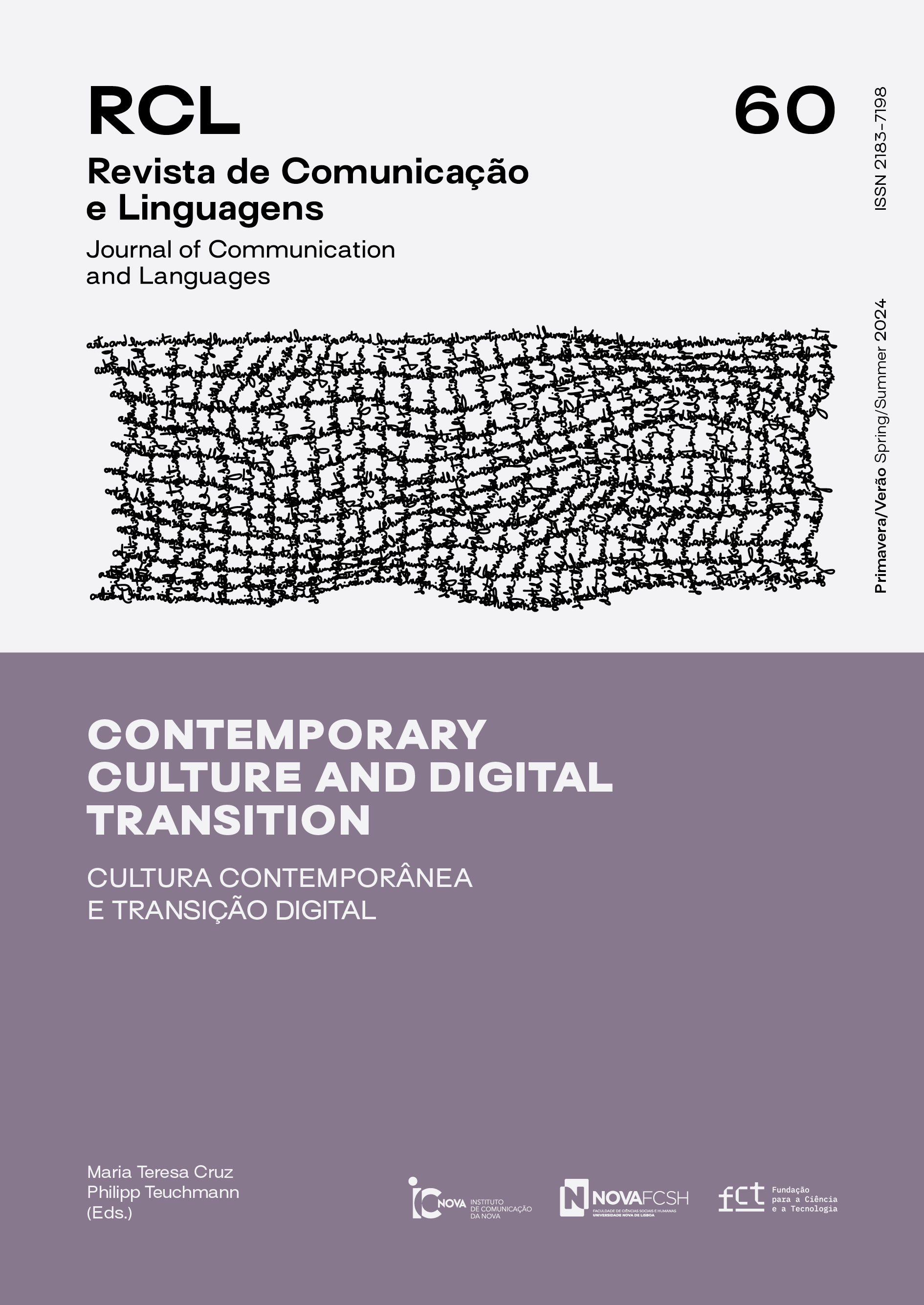Epistemic Interfaces of Visualization and Interpretation: a possible resistance to the myth of autonomous agency in AI
DOI:
https://doi.org/10.34619/20hf-ury5Keywords:
AI mythology, deep learning, social agency, digital anthropology, experimental ethnographyAbstract
Anthropological studies on agency and cognition have used theoretical frameworks of co-dependency and composition (between subjects and objects) to explain the technical production processes of knowledge. In this context, ethnographic studies were carried out on digital technologies (Horst y Miller 2012; Geismar y Knox 2021), namely on Artificial Intelligence (AI) (Forsythe 2001; Suchman 2007), both in re- lation to itsproduction — with its designers and programmers — and in its imple- mentation — on its uses and appropriations. However, according to authors such as Pink (2021) or Drucker (2020), we find less research that bringsthese anthropologi- cal theories to the design of the technologies that determine our current cognitive ecology, as is the case of deep learning. Thus, this paper’s contribution lies in the development of a collaborativeethnography — with a deep learning engineer — to generate two experimental human-AI interaction interfaces that offer possible re- sistance to the myth of autonomous agency that characterizes the official discourseof AI; a mythical speech (Barthes 1957) that, as will be argued through the description of the ethnographic work, does not correspond to the action of programming AI. Ha- ving this as a starting point, we presentthe hybrid method that guides this research between deep learning programming for artificial vision, computational interpretability techniques and the use of artistic strategies —, a methodology that allowed the incorporation of the ethnographic knowledge ofthe field work into the interface design, where the anthropological concepts of social agency (Gell 1998; Latour 1999) and user-maker (Ingold 2013) stand out.
References
Annany, Mike, and Kate Crawford. 2016. “Seeing without knowing: Limitations of the transparency ideal and its application to algorithmic accountability.” New Media & Society 20 (3): 973-989. https://doi. org/10.1177/1461444816676645.
Apprich, Clemens. 2018. “Secret Agents. A psychoanalytic Critique of Artificial Intelligence and Machine Learning.” Digital Culture & Society 4 (1): 29-44. https://doi.org/10.14361/dcs-2018-0104.
Barthes, Roland. 2012. Mitologías. Traducido por Héctor Schmucler. Madrid: Editorial Biblioteca Nueva. Carter, Shan, Zan Armostron, Ludwing Schubert, Ian Johnson, and Chris Olah. 2019. “Exploring Neural
Networks with Activation Atlases.” Distill. https://doi.org/10.23915/distill.00015.
Deleuze, Gilles, y Felix Guattari. 1985. El Anti Edipo: capitalismo y esquizofrenia. Traducido por Francisco Monge. Barcelona: Editorial Planeta.
Drucker, Johanna. 2020. Visualization and Interpretation. Cambridge: The MIT Press.
Dyson, George. 2015. La catedral de Turing: los orígenes del universo digital. Traducido por Francisco José Ramos Mena. Barcelona: Penguin Random House.
Forty, Adrien. 1986. Objects of Desire: design and society since 1750. London: Thames & Hudson.
Griffiths, Catherinne. 2018. “Visual Tactics Toward an Ethical Debugging.” Digital Culture & Society 4(1): 217-
https://doi.org/10.14361/dcs-2018-0113.
Gell, Alfred. 2016. Arte y agencia: una teoría antropológica. Traducido por Ramsés Cabrera Olivares. Buenos Aires: SB.
. 2006. The Art of Anthropology: essays and diagrams. New York: Berg.
Geismar, Haidy, and Hannah Knox, eds. 2021. Digital Anthropology. 2nd ed. New York: Routledge.
Holmes, Douglas, and George E. Marcus. 2008. “Collaboration Today and the Re-Imagination of the Classic Scene of Fieldwork Encounter.” Collaborative Anthropologies 1 (1): 81-101. https://doi.org/10.1353/ cla.0.0003.
Horst, Heather A. 2016. “Being in Fieldwork: collaboration, digital media and ethnographic practice.” In
eFieldnotes: the makings of anthropology in a digital world, edited by Roger Sanjek and Susan Tratner, 153-
University of Pennsylvania Press.
Hutchins, Edwin. 1995. Cognition in the Wild. Massachusetts: The MIT Press.
Ingold, Tim. 2013. Making: Anthropology, Archaeology, Art and Architecture. London: Routledge.
Larson, Erik J. 2022. El mito de la Inteligencia Artificial: por qué las máquinas no pueden pensar como nosotros lo hacemos. Traducido por Milo J. Krmpoti. España: Shackleton Books, S.L.
Latour, Bruno. 1986. “Visualisation and Cognition: thinking with eyes and hands.” In Knowledge and Society Studies in the Sociology of Culture Past and Present, vol. 6, edited by H. Kuklick and E. Long, 1-40. Jai Press.
. 2001. La esperanza de Pandora: ensayos sobre la realidad de los estudios de la ciencia. Traducido por Tomás Fernández Aúz. Barcelona: Gedisa, S.A.
Latour, Bruno, and Steve Woolgar. 1986. Laboratory Life: the construction of scientific facts. Princeton, New Jersey: Princeton University Press.
Lindsay, Grace. 2022. Models of the Mind: How physics, engineering and mathematics have shaped our understanding of the brain. London: Bloomsbury.
Magnet, Shoshana A. 2011. When Biometrics Fail: Gender, Race, and the Technology of Identity. Durham: Duke University Press.
Marcus, George E. 1995. “Ethnography in/of the World System: the emergence of multi-sited ethnography.”
Annual Review of Anthropology 24: 95-117. https://doi.org/10.1146/annurev.an.24.100195.000523.
Monin, Monica. 2018. “Unconventional Classifiers and Anti-social Machine Intelligences: Artists Creating Spaces of Contestation and Sensibilities of Difference Across Human-Machine Networks.” Digital Culture & Society 4 (1): 227-237. https://doi.org/10.25969/mediarep/13534.
Pink, Sarah. 2021. “Digital Futures Anthropology.” In Digital Anthropology,edited by H. Geismar and H. Knox, 2nd ed., 307-324. New York: Routledge.
Pink, Sarah, and Juan Francisco Salazar. 2017. “Anthropologies and Futures: setting the agenda.” En Anthropologies and Futures: researching emerging and uncertain worlds, edited by Juan Francisco Salazar, Sarah Pink, Andrew Irving and Johannes Sjöberg, 3-22. London: Bloomsbury.
Preston, John, and Mark Bishop, eds. 2002.Views into the Chinese Room: new essays on Searle and artificial intelligence. New York: Oxford University Press.
Searle, John. 1984. Minds, Brains and Science. Cambridge: Harvard University Press.
Sekula, Allan. 1986. “The Body and the Archive.” October 39: 3-64. https://doi.org/10.2307/778312. Suchman, Lucy. 2007. Human-Machine Reconfigurations: Plans and Situated Actions, 2nd ed. New York:
Cambridge University Press.
Verbeek, Peter-Paul. 2006. “Materializing Morality. Design Ethics and Technological Mediation.” Science, Technology, & Human Values 31 (3): 361-380. http://www.jstor.org/stable/29733944.
Downloads
Published
How to Cite
Issue
Section
License

This work is licensed under a Creative Commons Attribution-NonCommercial 4.0 International License.






